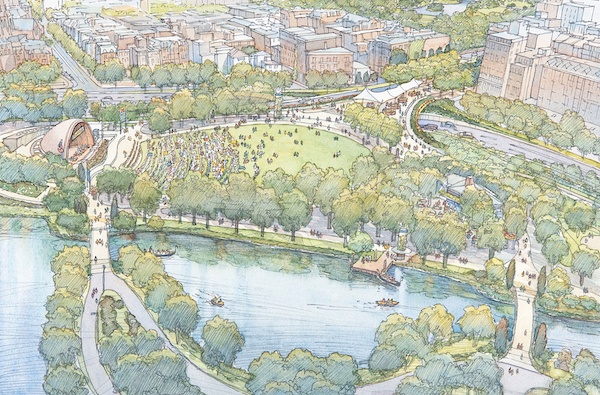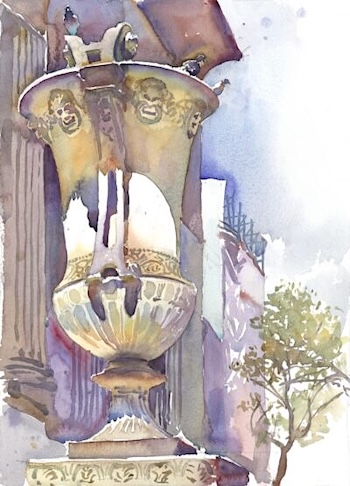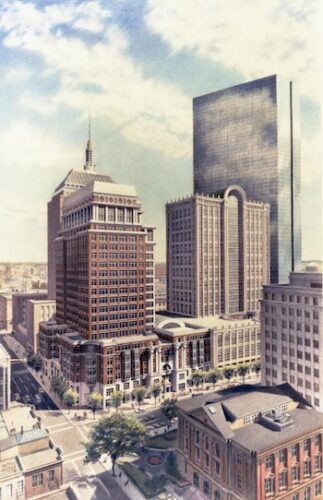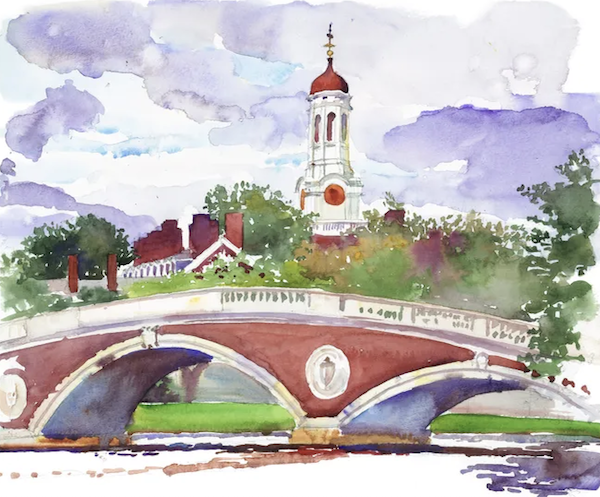Artist Feature: Architectural Illustrator Frank Costantino — Adding Soul to the Built Environment
By Mark Favermann
“Visionary Projects” at the Boston Athenaeum is a captivating exhibition of Frank M. Costantino’s work, a display of over 80 drawings and watercolors.

Frank M. Costantino, Esplanade Vision 2020 Hatch Shell Rendering, (watercolor).
There is an artistic treasure living, working, and creatively thriving in Winthrop, Massachusetts. Frank Costantino, an acclaimed architectural illustrator, initially trained at Pratt Institute before graduating from the Boston Architectural College (BAC). For over fifty years, Costantino has provided the world’s leading architects, designers, and developers with his brilliant, hand-drawn project visions. His greatest contribution: his ability to translate the geometry and specified construction materials into an elegant visualization of what a future project will look like in the world. Over the decades, Costantino has come to be regarded as one of the world’s most respected practitioners in the field of architectural illustration.

Frank M. Costantino, Decorative Urn at New York Public Library, watercolor
Visionary Projects, currently on view through May 3 at the Boston Athenaeum, is a captivating exhibition of Costantino’s work, a display of over 80 drawings and watercolors. The exhibition showcases a number of Boston and New England landmarks, including the Hynes Convention Center, the Boston Esplanade 2020 Vision, and the Old State House renovation. Costantino’s vibrant, joyful depictions, with their precise detailing, span from preparatory sketches to finished refined renderings.
As he has illustrated architectural projects around the world, Costantino has also developed a reputation as a watercolorist, capturing urban scenes, landscapes, homes, and portraits in a plein air or a direct alla prima colorist style. He has long participated in — and been recognized by — watercolor societies and visual arts organizations both locally, nationally, and internationally. His work is represented in select galleries as well as prominent permanent collections such a The Boston Athenaeum, Boston’s MFA, The Library of Congress, Tchobon Architecture DWGS Institute in Berlin, San Francisco Museum of Art, the Boston Architectural College, Art Institute of Chicago, and LA’s Skirball Museum, among them.
Costantino has collaborated with renowned architects, designers, and developers across the United States, Canada, Europe, and Japan. His distinguished clients have included Cesar Pelli, Moshe Safdie, I.M. Pei, Peter Bohlin, Joseph Esherick, Benjamin Thompson, Robert A.M. Stern, and José Luis Sert. Their projects encompass a range of skyscrapers, office buildings, museums, airports, transportation facilities, historic preservation projects, concert halls, and aquariums.
Costantino is a recipient of the world’s most prestigious award for architectural illustration – the Hugh Ferriss Memorial Prize – as well as many other awards from the American Society of Architectural Illustrators (ASAI). Hugh Ferris (1889-1962) is “the godfather” of architectural illustration. A Co-Founder of the American Society of Architectural Illustrators (ASAI), Costantino established an international network of delineators across the US, Canada, Japan, Australia, Korea, England, Europe, and many other countries. On behalf of the Society, with his ASAI Co-Founders, Costantino received Institute Honors from the American Institute of Architects in 1995. He has also received an Honorary AIA Fellowship (FAIA) sponsored by the Boston Society of Architects (BSA). In addition, he is an Honorary Life Member of the Japan Architectural Renderers Association (JARA), Tokyo, a Fellow of Society of Architectural Illustrators (FSAI), Great Britain, and Honorary Member of New York’s Society of Illustrators (SI).

Frank M. Costantino, 222 Berkeley Street, Back Bay Boston, Robert AM Stern Architects, NYC., watercolor
In recognition of his continuing contributions to ASAI since 1986, the Society awarded him its first Lifetime Achievement Award to Costantino. Since 1987, his drawings or paintings have been accepted into ASAI’s annual juried exhibitions, and artworks from his career have been published in more than sixty books or catalogs.
Regarding his creative process and perspective, Costantino speaks eloquently: “Light, shade, shadow, color, values, textures; the substantive and the fleeting, the design and contours of shape and form; the intersection and interplay of the tangible and intangible – these life qualities are always capturing my attention. The interpretative and unexpected possibilities of the watercolor medium present an exciting artistic challenge to capture these very qualities in every work.”
For him, responding to the exterior world is an act of philosophical reflection: “Life is the reality of the soul. Art is the expressive response or reflection of the soul to life’s fleeting reality, or ‘floating world’. My engagement with a subject is so strong and total, that the experience in making a work suffuses the record of my vision, and thereby that unique view of life. The truth of art connects with the truth of other humans. The clearer truth’s message is conveyed by the power of the artists’ skills; the stronger is the message, the greater and enduring is the art.” He underlines that creativity “is a passion; it is an imperative that is a profound, relaxing, and gratifying process. It is also a path of self-discovery and sharing a realization. It is a search for the beauty in all things.”
Today, there is a threat to the creative vision the horizon. Artificial Intelligence (AI) is seen by many as both a helpful tool and a potential danger. Our fascination with technology is inseparable from our anxieties. Architectural rendering is as vulnerable as any other artistic field. Besides using AI for research, architectural practices are drawing on it for two related visual functions: design ideations and concept designs. Design ideations give architects an opportunity to look at an image section of a building, often placing it in an imaginary landscape, adding objects like people and cars. This can be done with a few text prompts, which means that specialist rendering skills may no longer be needed. Concept designs software allows architects to manipulate their early-stage models and apply a range of stylistic iterations, playing with different material options and various design alternatives. The software delivers machined-tooled renderings. My own reaction to most images of this type is that they are rather sterile, even boring. I could easily call them soulless.

Frank M. Costantino, Harvard’s Weeks Bridge over the Charles River, watercolor
Regarding the rise and popularity of AI, Costantino responds with passion:
I am quite skeptical about the uses of such pre-determined, over-arching, pervasive digital “assets” in the field of architectural illustration. Whatever programs, solutions, imagery that might be useful would still take a discerning skill to apply appropriately to whatever image task is at hand.
In my field of architectural illustration, what has and will continue to get lost, homogenized, or eradicated is the distinctive touch & technique of the individual artist in executing a work of useful art for architects. In conjunction with my show at the Boston Athenaeum, I have mentioned to many that the distinctive hand-drawn media techniques – whether watercolor, pencil, pen & ink, or mixed media – of my many colleagues’ illustrations are readily identifiable to me and likely to others that have practiced in the field.
“My profession would be at a serious aesthetic loss if AI, utilized however diligently, caused the shriveling or disappearance of unique hand-made expressions – as would be the case in any art form.
In other words, Frank Costantino’s art has soul.
Mark Favermann is an urban designer specializing in strategic placemaking, civic branding, streetscapes, and retail settings. An award-winning public artist and sculptor, he creates functional public art as civic design and smaller functional objects. Early in his career, he was recognized for creating artistic events by transforming and documenting monumental structures into temporary sundials, including Charlestown’s Bunker Hill Monument, the St Louis Arch, and the then world’s tallest building — Chicago’s Sears (now Willis) Tower. The designer of the iconic Coolidge Corner Theatre Marquee, he is design consultant to the Massachusetts Downtown Initiative Program and since 2002 has been a design consultant to the Boston Red Sox.
Tagged: "Visionary Projects", Architectural Illustrator, Boston Athenaeum

Frank
You were one of the few that knew what he wanted and did it with great success.
Congratulations
Bob (gus) Foley